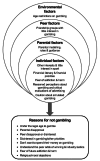'Getting addicted to it and losing a lot of money… it's just like a hole.' A grounded theory model of how social determinants shape adolescents' choices to not gamble
- PMID: 38724892
- PMCID: PMC11084133
- DOI: 10.1186/s12889-024-18286-3
'Getting addicted to it and losing a lot of money… it's just like a hole.' A grounded theory model of how social determinants shape adolescents' choices to not gamble
Abstract
Background: Gambling abstinence when underage lowers the risk of harmful gambling in later life. However, little research has examined why many young people refrain from gambling, even though this knowledge can inform protective strategies and lower risk factors to reduce underage gambling and subsequent harm. This study draws on the lived experience of adolescent non-gamblers to explore how social determinants while growing up have shaped their reasons and choices to not gamble.
Methods: Fourteen Australian non-gamblers, aged 12-17 years, participated in an in-depth individual interview (4 girls, 3 boys) or online community (4 girls, 3 boys). Questions in each condition differed, but both explored participants' gambling-related experiences while growing up, including exposure, attitudes and behaviours of parents and peers, advertising, simulated gambling and motivations for not gambling. The analysis used adaptive grounded theory methods.
Results: The grounded theory model identifies several reasons for not gambling, including not being interested, being below the legal gambling age, discouragement from parent and peers, concern about gambling addiction and harm, not wanting to risk money on a low chance of winning, and moral objections. These reasons were underpinned by several social determinants, including individual, parental, peer and environmental factors that can interact to deter young people from underage gambling. Key protective factors were parental role modelling and guidance, friendship groups who avoided gambling, critical thinking, rational gambling beliefs, financial literacy and having other hobbies and interests.
Conclusions: Choices to not gamble emanated from multiple layers of influence, implying that multi-layered interventions, aligned with a public health response, are needed to deter underage gambling. At the environmental level, better age-gating for monetary and simulated gambling, countering cultural pressures, and less exposure to promotional gambling messages, may assist young people to resist these influences. Interventions that support parents to provide appropriate role modelling and guidance for their children are also important. Youth education could include cautionary tales from people with lived experience of gambling harm, and education to increase young people's financial literacy, ability to recognise marketing tactics, awareness of the risks and harms of gambling, and how to resist peer and other normalising gambling influences.
Keywords: Adolescents; Gambling; Grounded theory; Protective factors; Qualitative methods; Social determinants; Youth.
© 2024. The Author(s).
Conflict of interest statement
I declare that the authors have no competing interests as defined by BMC, or other interests that might be perceived to influence the results and/or discussion reported in this paper.
Figures
Similar articles
-
Exploring Perspectives Towards the Gambling Industry and Its Marketing Strategies Among Young People in Western Australia.Health Promot J Austr. 2025 Apr;36(2):e955. doi: 10.1002/hpja.955. Health Promot J Austr. 2025. PMID: 39910804 Free PMC article.
-
Young people's recall and perceptions of gambling advertising and intentions to gamble on sport.J Behav Addict. 2018 Dec 1;7(4):1068-1078. doi: 10.1556/2006.7.2018.128. Epub 2018 Dec 23. J Behav Addict. 2018. PMID: 30580544 Free PMC article.
-
"It's changing our lives, not for the better. It's important that we have a say". The role of young people in informing public health and policy decisions about gambling marketing.BMC Public Health. 2024 Jul 26;24(1):2004. doi: 10.1186/s12889-024-19331-x. BMC Public Health. 2024. PMID: 39060997 Free PMC article.
-
Perceptions, people and place: Findings from a rapid review of qualitative research on youth gambling.Addict Behav. 2019 Mar;90:99-106. doi: 10.1016/j.addbeh.2018.10.008. Epub 2018 Oct 9. Addict Behav. 2019. PMID: 30384191 Free PMC article. Review.
-
Family influences on adolescent gambling behavior: a review of the literature.J Gambl Stud. 2010 Dec;26(4):503-20. doi: 10.1007/s10899-010-9181-5. J Gambl Stud. 2010. PMID: 20349270 Review.
Cited by
-
Substantiating policy recommendations for reducing gambling-related harms with perspectives from individuals with lived experience.Curr Opin Psychiatry. 2025 Jul 1;38(4):259-264. doi: 10.1097/YCO.0000000000001008. Epub 2025 Apr 1. Curr Opin Psychiatry. 2025. PMID: 40166986 Review.
References
-
- Rossen F, Butler R, Denny S. An exploration of youth participation in gambling & the impact of problem gambling on young people in New Zealand. Auckland: Auckland UniServices Limited; 2011.
Publication types
MeSH terms
Grants and funding
LinkOut - more resources
Full Text Sources
Medical


